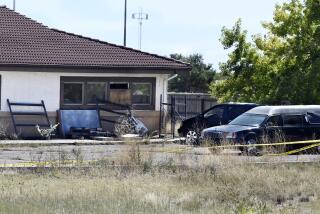For human dissection needs, the body count is low
- Share via
DENVER — Jonathan Dameworth haunts his professor’s office three times a week, trying to wheedle his way into a human dissection class scheduled for fall at Colorado State University.
If he can’t get in, the 21-year-old said, he’ll have to spend an extra semester earning the credits he needs for his minor in biomedical sciences.
His professor is sympathetic. The problem is, the class already has too many live humans and too few dead ones.
For the first time in two decades, the organization that distributes donated cadavers to medical and undergraduate schools in Colorado and Wyoming doesn’t have enough to go around.
Colorado’s Anatomical Board, which typically receives up to 160 cadavers per year, finds itself with a shortfall of about 20, even after changing its standards to accept heavier corpses.
Colorado officials cite a growing demand by new schools and expanded programs, as well as competition from private tissue procurement companies vying for the same historically small supply of bodies.
That’s true across the nation, said Arthur Caplan, who heads the University of Pennsylvania’s medical ethics department.
“Demand is up,” Caplan said. Not only are there more medical, dental and nursing programs, but surgeons want cadavers to hone new procedures; researchers want bodies for experimental purposes and various medical procedures.
No easy solution
The supply isn’t keeping pace. Caplan said donors historically have come from two small pools: alumni, and others who simply want to do good.
The rest of the population tends to be ambivalent about donating bodies to science, he said.
“It’s never been a big number, and it doesn’t take a lot to tip the supply,” Caplan said.
It’s difficult for academic programs to find ways to increase their donations, said Richard L. Drake of the American Assn. of Anatomists. Though some programs have a sufficient supply, “everyone is closer to their minimums than they used to be,” he said.
Now they face competition from the human tissue industry, which secures donations, then provides the bodies or body parts to research firms, often at a significant profit.
Such companies advertise and tend to be aggressive about pursuing donations, Caplan said, whereas academics operate on shoestring budgets. “It’s not a balanced playing field,” he said.
The American Assn. of Tissue Banks did not return a call seeking comment, but one company operating in Colorado disagreed that the firms’ approach is more aggressive.
Community groups approach them as frequently as the company solicits for donations, said Donna Goyette, spokeswoman for Science Care, which runs a training facility in Colorado where surgeons practice procedures. It also provides cadavers to research firms across the country.
Goyette said donating to private tissue companies offers some benefits that academic programs do not, such as covering transportation costs for the body. Science Care also returns the cremated remains to the family within five weeks, whereas universities may keep remains for up to two years, she said.
Science Care, like most such firms, runs newspaper advertisements, although Goyette said those haven’t yielded a large percentage of the company’s donations. It has about 30,000 people on its donor list nationwide, she said.
Spreading the word
Medical schools and the boards seeking donations on their behalf eschew overt marketing, Drake said. Instead, they “quietly advertise” through word of mouth, he said.
After a cadaver shortage 10 years ago, the Anatomical Gift Assn. of Illinois did try being more overt, running newspaper ads. It didn’t help, said Paul Dudek, the association’s executive director.
The trend continues downward, he said. In the 1980s, Illinois received up to 900 donations per year. It now averages about 500.
Dudek cites two factors: the growing popularity of cremation, and competition from tissue companies.
Experts interviewed do not believe that scandals involving the mishandling of bodies -- such as one at UCLA in 2004 in which employees allegedly sold body parts for personal profit -- have affected donations.
Such incidents may give people pause, but they don’t seem to have more than a temporary effect on donations, Caplan said.
In the University of California system, donations have remained steady over the last five years, averaging about 1,000 per year, said Brandi Schmitt, director of anatomical services.
Denver-area resident Corinne Osborne has her own theory about why people don’t donate: They just don’t know about it. She handled the donation of her parents’ bodies to the state Anatomical Board, something they had decided three decades earlier they wanted done.
“My father felt it was a purposeful thing to do this, to donate his body. He loved learning, even to the age of 84. He felt somebody could learn from him,” said Osborne, 56, a unit secretary at a local emergency room.
When she tells others about the experience, they’re usually surprised, she said.
“They’re totally clueless you could do this. Some have said, ‘Golly, I could’ve done that with Mom and Dad.’ ”
Colorado officials have discussed advertising but feel it would be inappropriate, said Mike Carry, secretary-treasurer of the Anatomical Board. Instead, the board will continue to send information about the program to hospice, hospital and nursing home programs.
Med students first in line
For now, Carry said, the board is adjusting by assigning first priority to medical students. That means undergraduate programs are preparing for a lean year.
“This year, I requested 15 and we’ll get seven. So now I’m cutting back on students that can take dissection,” said Mark Frasier, an associate professor in Colorado State University’s department of biomedical sciences. “It’s such a shame. I have the room, all the things we need to teach, and I can’t do it.”
Because he’s giving first priority to master’s-level students who must take the class, undergraduates like Dameworth and Holly Filak, 20, may find themselves cut out. Filak, a pre-med student, is resigned to the possibility that she may miss out on the experience. “I would love to take this class,” she said. Although she has used a computer program to replicate the dissection experience, it’s not the same, she said.
“It’s just a whole different feeling with having the real thing,” she said.
--
More to Read
Sign up for Essential California
The most important California stories and recommendations in your inbox every morning.
You may occasionally receive promotional content from the Los Angeles Times.













